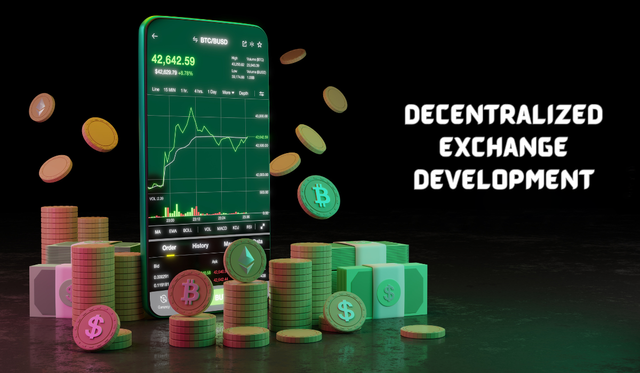The rapid growth of the cryptocurrency market has led to the emergence of various trading platforms. Among these, decentralized exchanges (DEXs) have gained significant traction due to their unique advantages over centralized exchanges (CEXs). As the demand for privacy, security, and control over assets increases, DEXs are becoming a cornerstone of the crypto ecosystem. This blog explores the development of decentralized exchanges, their benefits, challenges, and future prospects.

What is a Decentralized Exchange?
A decentralized exchange is a platform that allows users to trade cryptocurrencies directly with one another without the need for a central authority or intermediary. Unlike centralized exchanges, which hold users' funds and facilitate trades through their own servers, DEXs operate on blockchain technology. This ensures that users retain control of their private keys and funds throughout the trading process.
Key Components of a Decentralized Exchange
1. Smart Contracts
Smart contracts are self-executing contracts with the terms of the agreement directly written into code. They are the backbone of DEXs, enabling automated, trustless transactions between parties. When a trade is initiated on a DEX, a smart contract manages the transaction, ensuring that both parties fulfill their obligations before the trade is finalized.
2. Liquidity Pools
Liquidity pools are collections of funds locked in a smart contract. They provide the liquidity needed for trading on DEXs, allowing users to swap tokens without requiring a direct counterparty. Liquidity providers (LPs) add funds to these pools and earn rewards in the form of trading fees or native tokens of the platform.
3. Automated Market Makers (AMMs)
AMMs are protocols that use mathematical formulas to price assets within liquidity pools. Unlike traditional order book models, AMMs ensure continuous liquidity by allowing users to trade against the pool. Popular AMM models include Constant Product Market Maker (used by Uniswap) and StableSwap (used by Curve).
Benefits of Decentralized Exchanges
- Security
Since users retain control over their funds and private keys, DEXs significantly reduce the risk of hacks and thefts that plague centralized exchanges. There is no single point of failure, making it harder for malicious actors to compromise the platform.
- Privacy
DEXs typically require minimal personal information, preserving user anonymity. This is a stark contrast to CEXs, which often mandate extensive KYC (Know Your Customer) processes.
- Censorship Resistance
Operating on blockchain networks, DEXs are inherently resistant to censorship. No central authority can interfere with or block transactions, ensuring that users can trade freely.
- Global Accessibility
DEXs are accessible to anyone with an internet connection and a cryptocurrency wallet. They are not bound by geographical restrictions or regulatory hurdles, promoting financial inclusion.
Challenges in Decentralized Exchange Development
1. User Experience
One of the major challenges for DEXs is providing a user-friendly experience. The complexity of managing private keys, interacting with smart contracts, and understanding liquidity pools can be daunting for new users. Improving the UI/UX is crucial for broader adoption.
2. Scalability
Blockchain networks, especially those like Ethereum, can face scalability issues, leading to high transaction fees and slow processing times during peak periods. Layer 2 solutions and alternative blockchain platforms are being explored to address these limitations.
3. Liquidity
Achieving sufficient liquidity is essential for the smooth operation of a DEX. Without adequate liquidity, users may face high slippage and difficulty in executing trades. Incentivizing liquidity providers through rewards and yield farming is one way to mitigate this challenge.
4. Regulatory Uncertainty
The regulatory landscape for cryptocurrencies is still evolving. DEXs operate in a legal grey area in many jurisdictions, raising concerns about compliance and the potential for future regulatory crackdowns.
Future Prospects of Decentralized Exchanges
1. Interoperability
The future of DEXs lies in cross-chain interoperability, enabling seamless trading across different blockchain networks. Protocols like Polkadot and Cosmos are working towards creating a connected ecosystem, which will enhance the utility and reach of DEXs.
2. Layer 2 Solutions
Layer 2 solutions, such as rollups and sidechains, aim to improve scalability by processing transactions off the main blockchain while maintaining security. These innovations are expected to reduce transaction costs and increase throughput, making DEXs more efficient.
3. Decentralized Finance (DeFi) Integration
DEXs are integral to the DeFi ecosystem, providing the infrastructure for decentralized lending, borrowing, and other financial services. The continued growth of DeFi will likely drive further innovation and adoption of DEXs.
4. Improved Security Measures
Advancements in cryptographic techniques and decentralized identity solutions are expected to enhance the security and trustworthiness of DEXs. Multi-signature wallets and hardware wallets are becoming more user-friendly, adding an extra layer of security for users.
Conclusion
Decentralized exchanges represent a significant shift towards a more secure, private, and inclusive financial system. While they face challenges, ongoing technological advancements and a growing user base are driving their evolution. As DEXs continue to mature, they have the potential to redefine the landscape of cryptocurrency trading, offering a compelling alternative to traditional financial systems.